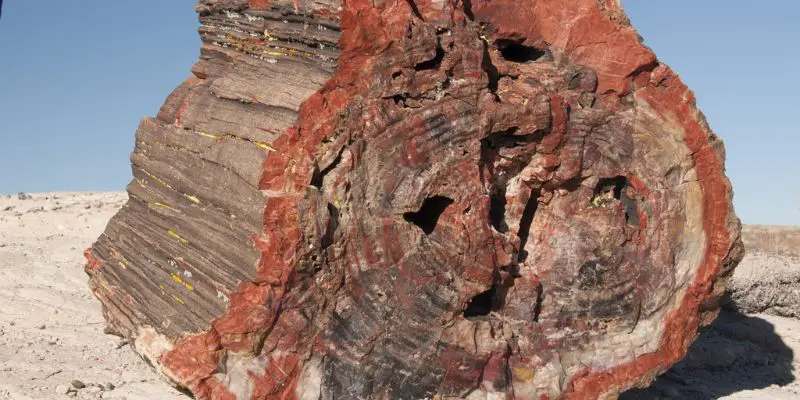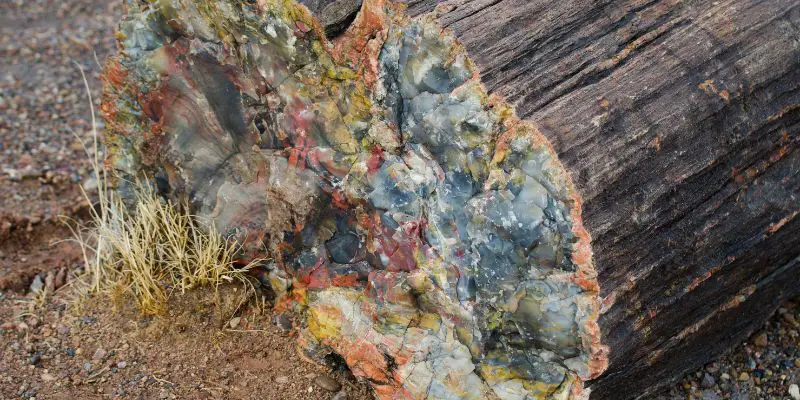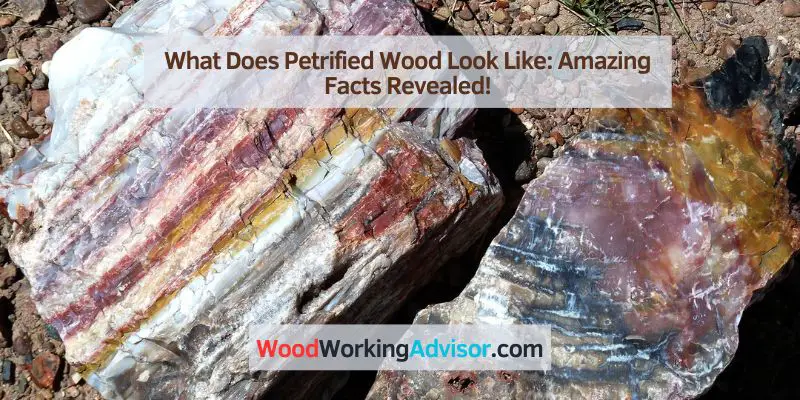Petrified wood looks like actual wood, but it has turned into stone over time due to the process of fossilization. The process involves the gradual replacement of organic material with minerals, resulting in a detailed preservation of the original wood structure.
Petrified wood often displays a range of colors, including earthy browns, reds, and yellows, with the wood’s grain and texture still visible. This stunning transformation makes petrified wood a popular choice for both interior and exterior decor, as well as in jewelry and art pieces.
The unique beauty and historical significance of petrified wood continue to captivate people, serving as a testament to the passage of time and the wonders of nature.
Unveiling Petrified Wood
Petrified wood, with its captivating appearance, has intrigued people for centuries. Its unique structure preserves the original wood but replaces it with minerals, creating a stunning spectacle. Let’s delve into the definition, geological process, and factors influencing the petrification of wood.
Definition Of Petrified Wood
Petrified wood is fossilized wood where the organic materials have been replaced by minerals, preserving the structure and grain of the original wood. The process of petrification occurs over millions of years, resulting in a remarkable stone-like appearance.
Geological Process Of Petrification
The geological process of petrification involves the gradual replacement of organic wood with minerals such as silica, quartz, and even opal. This transformation occurs as the wood becomes buried in sediment and mineral-rich water gradually seeps through the porous structure. Over time, the minerals replace the organic matter, resulting in the formation of petrified wood.
Factors Influencing Wood Petrification
Several factors influence the petrification of wood, including the type of wood, the surrounding geological environment, and the specific minerals present in the water. The varying conditions such as temperature, pressure, and the mineral content play a crucial role in determining the color and texture of the petrified wood.

Visual Characteristics
Petrified wood exhibits a range of visual characteristics, including vibrant colors, wood grain patterns, and a distinctive smooth texture. Its appearance can resemble that of regular wood, but with the added preservation effects of fossilization, resulting in unique and stunning natural formations.
Texture And Color Variations
Petrified wood is known for its remarkable visual appeal, characterized by its distinct texture and color variations. The texture of petrified wood is typically smooth and polished, resulting from the replacement of organic material by minerals over millions of years. The color variations, ranging from earthy tones to vibrant hues, are a result of the different minerals that have permeated the wood during the petrification process. This unique combination of texture and color variations makes petrified wood a highly sought-after material for both geological enthusiasts and interior decorators alike.
Impact Of Mineral Content On Appearance
The mineral content present during the petrification process plays a pivotal role in determining the appearance of petrified wood. Minerals such as iron oxide contribute to the reddish-brown hues, while manganese may result in deep purples and pinks. Each mineral imparts its distinct color and luster to the wood, creating a visually stunning array of patterns and shades. This intricate interplay of minerals gives petrified wood its exquisite and mesmerizing appearance, making each piece a natural work of art that tells its own unique geological story.
Comparison With Regular Wood
When compared with regular wood, petrified wood exhibits a stark contrast in both appearance and physical properties. While regular wood possesses a grainy texture and is susceptible to decay, petrified wood stands out with its smooth, polished surface and remarkable durability. The vibrant colors and intricate patterns found in petrified wood are absent in regular wood, showcasing the remarkable transformation that occurs during the petrification process.
What Does Petrified Wood Look Like?’
Petrified wood is a fascinating natural wonder that offers unique beauty and historical significance. But what does petrified wood actually look like? Let’s explore the common shapes and sizes, how to identify petrified wood in nature, and the differences in species and location.
Common Shapes And Sizes
Petrified wood comes in a variety of shapes and sizes, reflecting the diversity of the original trees that existed millions of years ago. It can be found in forms ranging from small, polished pieces to large, intricate logs. The color of petrified wood ranges from rich browns and reds to more unusual shades like green and blue, giving it an exceptional visual appeal.
Identifying Petrified Wood In Nature
Identifying petrified wood can be an exciting experience when exploring nature. Look for distinct patterns and textures, as well as tiny pores and grain structures that resemble those found in living wood. Keep an eye out for irregular shapes that hint at the original tree’s growth pattern. It’s essential to keep in mind that petrified wood may also have fossils or distinctive markings from its ancient environment.
Differences In Species And Location
Petrified wood can vary significantly depending on the species of the original tree and the location where it was preserved. Certain species may have distinct cellular structures or coloration, while different geological environments can result in unique mineral compositions and textures. By considering these factors, you can gain a deeper appreciation for the incredible diversity that petrified wood offers.
Exploration Of Distinct Patterns
Petrified wood is a fascinating natural wonder, valued for its unique beauty and inherent history. A key aspect of petrified wood that captivates explorers and enthusiasts is its distinct patterns. Let’s delve into the exploration of these extraordinary patterns and the unique features of petrified wood. From its rings and bark details to its overall appearance, petrified wood showcases remarkable patterns that tell a story spanning millions of years.
Rings And Bark Details
When examining petrified wood, you can often observe intricately preserved rings and bark details, mirroring the original structure of the tree. The growth rings present in petrified wood, also known as tree rings or annual rings, provide a fascinating glimpse into the age and growth patterns of the ancient tree. These rings are often visually striking, with varying colors and textures that highlight the organic nature of the wood.
Unique Features Of Petrified Wood
Aside from the rings and bark details, petrified wood boasts several other unique features that make it a captivating natural artifact. The vibrant array of colors presented within the wood is notably striking, ranging from earthy browns to vivid reds and blues, showcasing the vibrant mineral composition and environmental conditions during the petrification process. Additionally, the intricate cell structure of petrified wood offers a mesmerizing tapestry of natural artistry, with each cell preserved in exquisite detail.
Amazing Facts About Petrified Wood
Petrified wood is a fascinating natural wonder that captures the imagination with its stunning beauty and unique characteristics. Here are several amazing facts about petrified wood that will pique your interest and deepen your appreciation for this captivating material.
Worldwide Locations With Petrified Forests
One of the most remarkable aspects of petrified wood is the diverse range of locations where it can be found. From the colorful expanses of Petrified Forest National Park in Arizona, USA, to the vibrant landscapes of Petrified Forest of Lesvos in Greece, these worldwide locations boast some of the most impressive petrified forests on the planet. Additionally, areas such as Argentina’s La Leona Petrified Forest and Indonesia’s Petrified Wood Forest offer visitors the chance to marvel at the ancient allure of petrified wood in breathtaking settings.
Historic And Cultural Significance
The historic and cultural significance of petrified wood spans centuries and is revered by numerous indigenous cultures worldwide. In many ancient civilizations, petrified wood was valued for its spiritual significance and utilized in ceremonial rituals and traditional art forms. Today, petrified wood continues to hold a place of reverence in the cultural heritage of various indigenous communities, serving as a symbol of connection to the earth and ancestral wisdom.
Uses Of Petrified Wood Today
Modern uses of petrified wood extend beyond its aesthetic appeal, with practical applications that make it a valuable resource in industries such as interior design, jewelry making, and landscaping. Petrified wood has become a sought-after material for creating unique furniture pieces, elegant home decor accents, and stunning jewelry items. Its durability and captivating visual appeal make it a popular choice for adding a touch of natural beauty to contemporary designs and architectural projects.

The Rarity And Value Factor
When it comes to petrified wood, the rarity and value factor are crucial considerations for collectors and enthusiasts. The unique beauty and historical significance of petrified wood make it a highly sought-after specimen in the world of geology and natural history. Let’s explore the factors affecting its value and rarity, as well as responsible collecting practices that ensure the preservation of this fascinating natural treasure.
Factors Affecting Value And Rarity
Several key factors contribute to the value and rarity of petrified wood:
- Wood species: Certain species of wood, such as ancient sequoias or exotic tropical species, are rarer and thus more valuable when petrified.
- Color and pattern: The vividness of color and intricate patterns within the wood can significantly impact its value. Vibrant hues and distinct patterns are highly prized by collectors.
- Size and completeness: Large, intact specimens are more rare and therefore command higher prices in the market. Additionally, unique formations or complete cross-sections of tree trunks are highly valued.
- Location and source: The geological site where the petrified wood is found can greatly influence its rarity. Specimens from renowned locales or historically significant sites may hold greater value.
- Age and preservation: Older specimens and those with exceptional preservation, including detailed cell structures, often fetch higher prices due to their rarity and scientific significance.
Collecting Petrified Wood Responsibly
Responsible collecting practices are essential to preserving the natural beauty and historical importance of petrified wood:
- Observe local regulations: Before collecting petrified wood, research and adhere to any local laws or regulations concerning fossil or mineral collecting in the area.
- Maintain site integrity: Avoid damaging the surrounding environment or geological formations while collecting. Leave the site undisturbed for future enthusiasts to appreciate.
- Documentation and education: Properly document the location and details of any specimens collected, contributing to scientific knowledge while promoting responsible stewardship of natural resources.
- Support ethical sources: When purchasing petrified wood, support reputable dealers who adhere to ethical collecting and selling practices, ensuring the continued preservation of these valuable artifacts.
Protecting Petrified Wood Treasures
Petrified wood is truly an ancient treasure, offering a glimpse into Earth’s history through its stunning display of colors and patterns. However, as these natural wonders are increasingly sought after for their beauty and rarity, it becomes crucial to understand the importance of protecting petrified wood treasures. Let’s delve into the efforts aimed at conserving these geological marvels and the role they play in environmental education and sustainable tourism.
Conservation Efforts And Regulations
Preserving petrified wood requires dedicated conservation efforts and adherence to specific regulations. Various national parks and protected areas where petrified wood is found have established guidelines to safeguard these fossils. These regulations often prohibit the collection or removal of petrified wood from its natural habitat, ensuring that these unique formations remain intact for future generations to admire.
Role Of Petrified Wood In Environmental Education
The petrified wood serves as a valuable tool for environmental education, offering an opportunity to study ancient ecosystems and geological processes. Through interpretive programs and educational initiatives within protected areas, visitors can gain a deeper understanding of the significance of these fossils, fostering a sense of appreciation and responsibility for natural preservation.
Encouraging Sustainable Tourism
In promoting sustainable tourism, it is essential to raise awareness about the fragility of petrified wood and the importance of leaving these treasures undisturbed in their natural surroundings. By supporting responsible tourism practices and advocating for the protection of petrified wood, visitors can contribute to the conservation of these remarkable geological formations.
Frequently Asked Questions Of What Does Petrified Wood Look Like
How Do You Know If It’s Petrified Wood?
Petrified wood looks like regular wood but is heavier and harder. Look for wood grain patterns and colors replaced by minerals. Also, tap it to hear a stone-like sound. If in doubt, seek expert opinion to confirm.
How Many Years Does It Take To Petrify Wood?
It takes millions of years for wood to petrify due to the slow replacement of organic material with minerals.
Is Petrified Wood Actually Rock?
Yes, petrified wood is actually rock formed from the gradual replacement of wood by minerals over time.
Does Petrified Wood Have Any Value?
Yes, petrified wood can hold significant value as a decorative item and in the field of archaeology.
Conclusion
In short, the appearance of petrified wood varies from piece to piece, showcasing a beautiful range of colors and patterns. Understanding what petrified wood looks like can help you identify it in nature and appreciate its unique beauty. Whether you’re a collector, a geology enthusiast, or simply curious, petrified wood offers a fascinating glimpse into Earth’s ancient history.
Appreciating its unique beauty.


